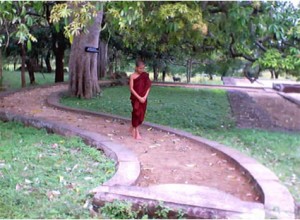The essence of the Buddha’s teaching is to develop the wisdom to be freed from suffering. NOTHING IS PERMANENT. Everything comes and goes. Yet when we lose something that we like, we feel sad. If, however, we can look at life with wisdom, we can see that things do not happen the way we want, but according to IMPERSONAL NATURAL LAWS.
Realization of the IMPERMANENCE (ANICCA), UNSATISFACTORINESS (DUKKHA), and IMPERSONALITY (ANATTA) of all phenomena comes through observing each and every thing with wisdom. This is Vipassana (Insight) Meditation, also known as Panna (Wisdom) Meditation. Vipassana Meditation is a completely different practice than Samatha Meditation. While concentration is a basic necessity, the mind is not kept in one-pointed fixation on a single object, as in Samatha Meditation. ANYTHING THAT COMES TO ONE’S AWARENESS THROUGH ANY OF THE SIX SENSE DOORS CAN BE AN OBJECT FOR VIPASSANA MEDITATION.
Being mindfully aware of the FOUR POSTURES (IRIYAPATHA) – SITTING, STANDING, WALKING, AND LYING DOWN – is an important part of Vipassana Meditation. When seated, be aware of sitting posture. While standing, be aware of standing. When walking and lying down, these also should be mindfully noticed. This may seem simple to practice and some may think that this is of no benefit, but when the mind remains constantly aware of these four postures, meditation progresses very well.
IT IS ALSO IMPORTANT TO GO THROUGH ALL DAILY ACTIVITIES WITH AWARENESS (SATI SAMPAJANNA). Washing, eating, drinking, bathing, dressing, and etc should all be done with constant mindfulness. For example, while drinking a cup of tea at the table, be aware of STRETCHING THE ARM… TOUCHING THE CUP… LIFTING THE CUP TO YOUR LIPS… SLANTING THE CUP… DRINKING… DRINKING… RETURNING THE CUP TO THE TABLE… and finally, REMOVING YOUR HAND.


